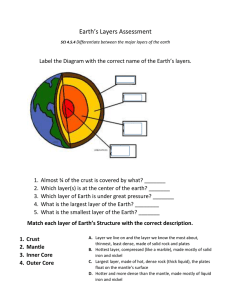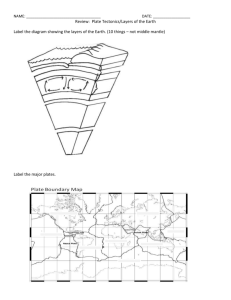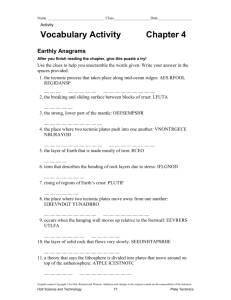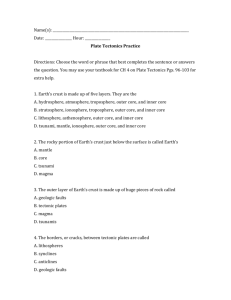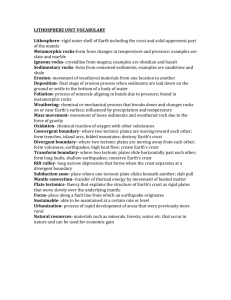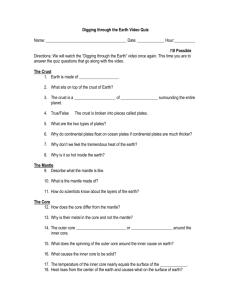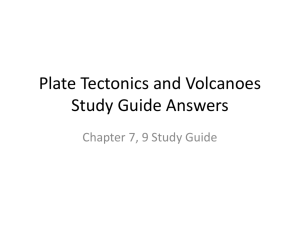Chapter 7: Plate Tectonics
advertisement
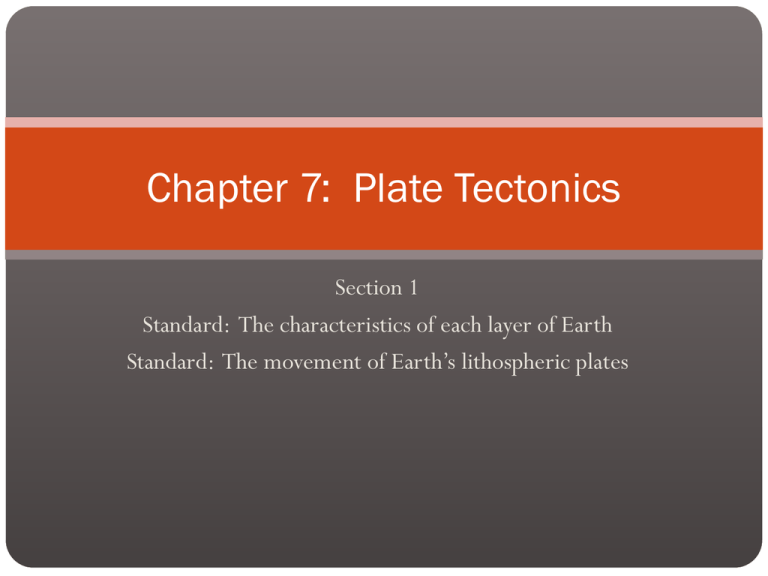
Chapter 7: Plate Tectonics Section 1 Standard: The characteristics of each layer of Earth Standard: The movement of Earth’s lithospheric plates Section 4 Deforming the Earth’s Crust pp.206-213 Standard: The relationship between the movement of the lithospheric plates and major geological features and events EQ: What kind of plate movement builds mountains? Deformation Process that changes the shape of rocks as the result of stress Types of Stress Compression—squeeze together Tension—stretched apart Folding—bending the rock Fault—when rocks break & slide past each other 3 Types of Mountains Folded Mountains Occurs at convergent boundaries Rock layers compress, squeeze & push together Produce tallest mountains Fault Block Mountains Tension causes large block of crust to drop below other blocks of sedimentary rock Makes mountains with sharp, jagged edges Volcanic Mountains Located at convergent boundaries at subduction zones Remember sea floor spreading May form under the ocean & eventually make islands Common in the Ring of Fire in Pacific Ocean EQ: How do the plates move vertically? Uplift Crust pushes up, like in mountain building Subsidence Sinking of cooler rocks, especially on the ocean floor EQ: What are tectonic plates? Tectonic plates Pieces of the lithoshere that move on top of the asthenosphere Plates may be continents, oceans or a combination, Thick continental plates displace or sink more into the asthenesphere than thin oceanic plates do. Summary Draw a diagram of each of the 3 types of mountains. Label it with the type of mountain Explain how the mountain was formed. EQ: How do scientists know about the deep layers of Earth? Seismic waves Vibrations from earthquakes Wave speed determined by the material they travel through. Faster through solids than liquids Density & thickness of the layers are calculated by the speed & travel time of the wave. The crust, mantle and core describe the chemical composition of Earth. Crust Outermost layer Thinnest layer 2 Types of Crust— Continental is made of oxygen, silicon, aluminum. 2. Oceanic is made of iron, calcium, magnesium, as well as O2, Si, and Al. 1. Mantle Thickest layer 67% of Earth’s mass Temp. 1000 C to 3700 C More dense than crust Has more magnesium Made of molten material -magma Core Center of Earth 33% of earth’s mass Temp. 3700 C to 7000C Made of iron and nickel EQ: What are the 5 physical layers of Earth? Lithosphere Outermost, rigid layer 2 Parts Crust 2. Rigid, upper part of mantle; the dividing line between crust & mantle Divided into tectonic plates 1. Asthenosphere “Plastic”, top layer of mantle that holds the tectonic plates Allows the plates move slowly Made of solid rock Mesosphere Rest of the mantle Made of molten rock-- magma Why is the inner core solid? Outer Core Liquid iron and nickel Inner Core Solid iron and nickel Most dense layer of Earth EQ: What are tectonic plates? Tectonic Plates Pieces of the lithosphere that move on top of the asthemosphere May be continents, oceans or a combination Thick continental plates displace or sink into the asthenosphere more than thin oceanic plates EQ: How do scientists know about the deep layers of Earth? Seismic Waves Vibrations from Seismograph Records earthquake data earthquakes Speed determined by the material they travel through Solids faster than liquids Density & thickness determined by speed & travel time SUMMARY Write a paragraph that explains the relationship between the 3 main layers of Earth and the 5 physical layers.
